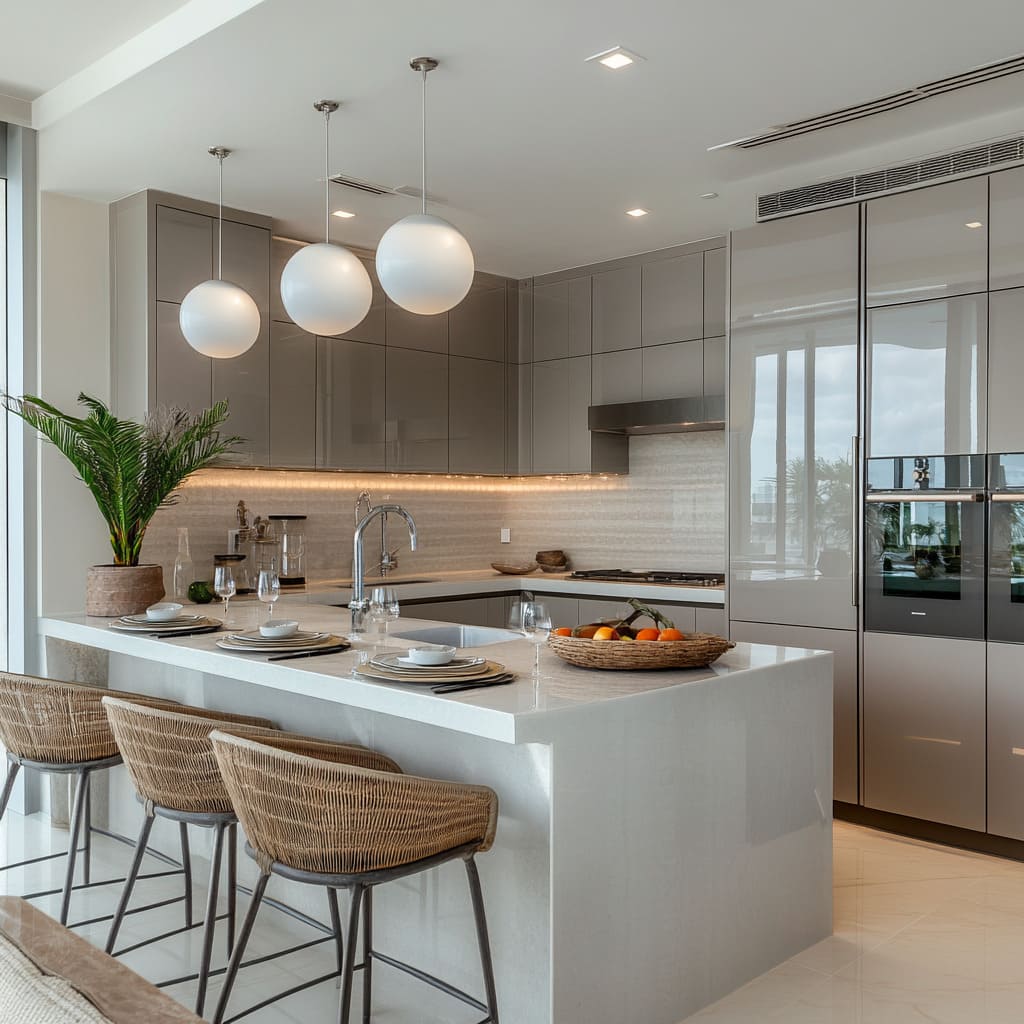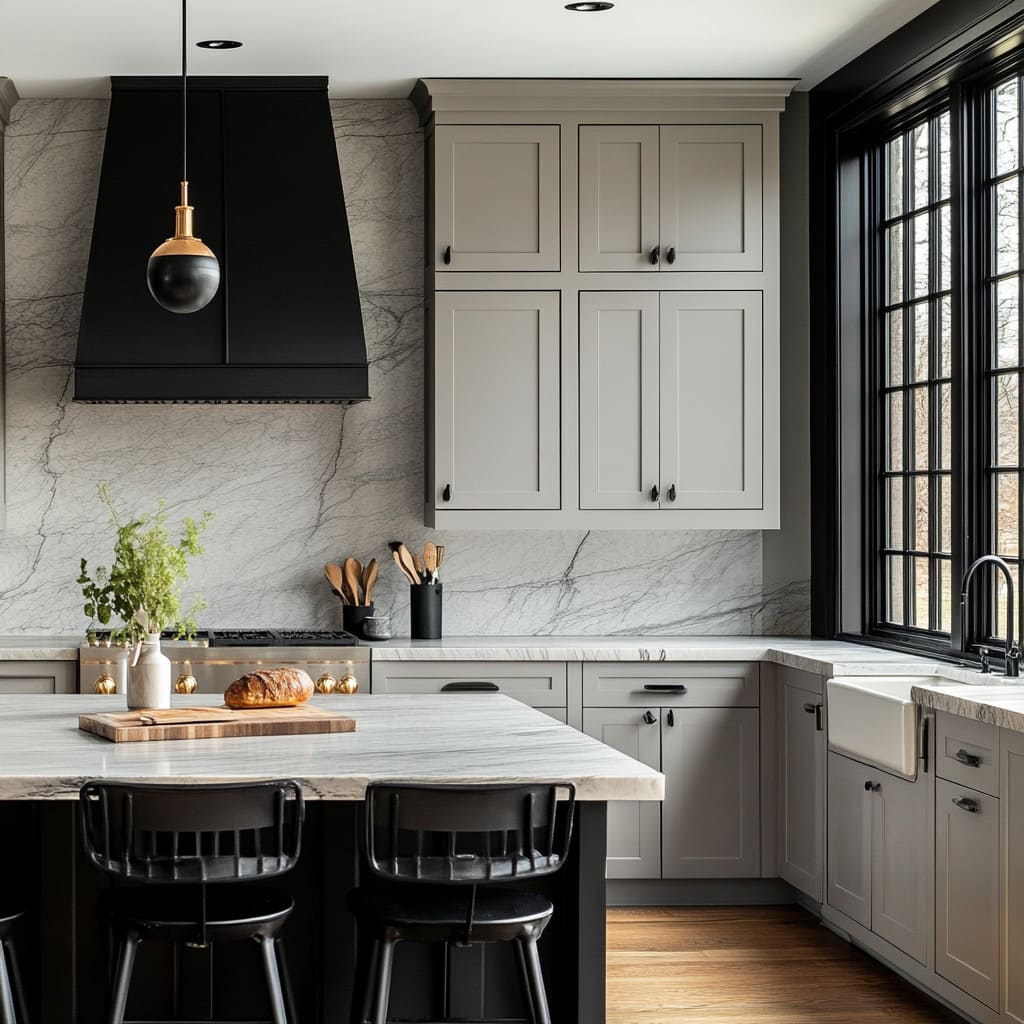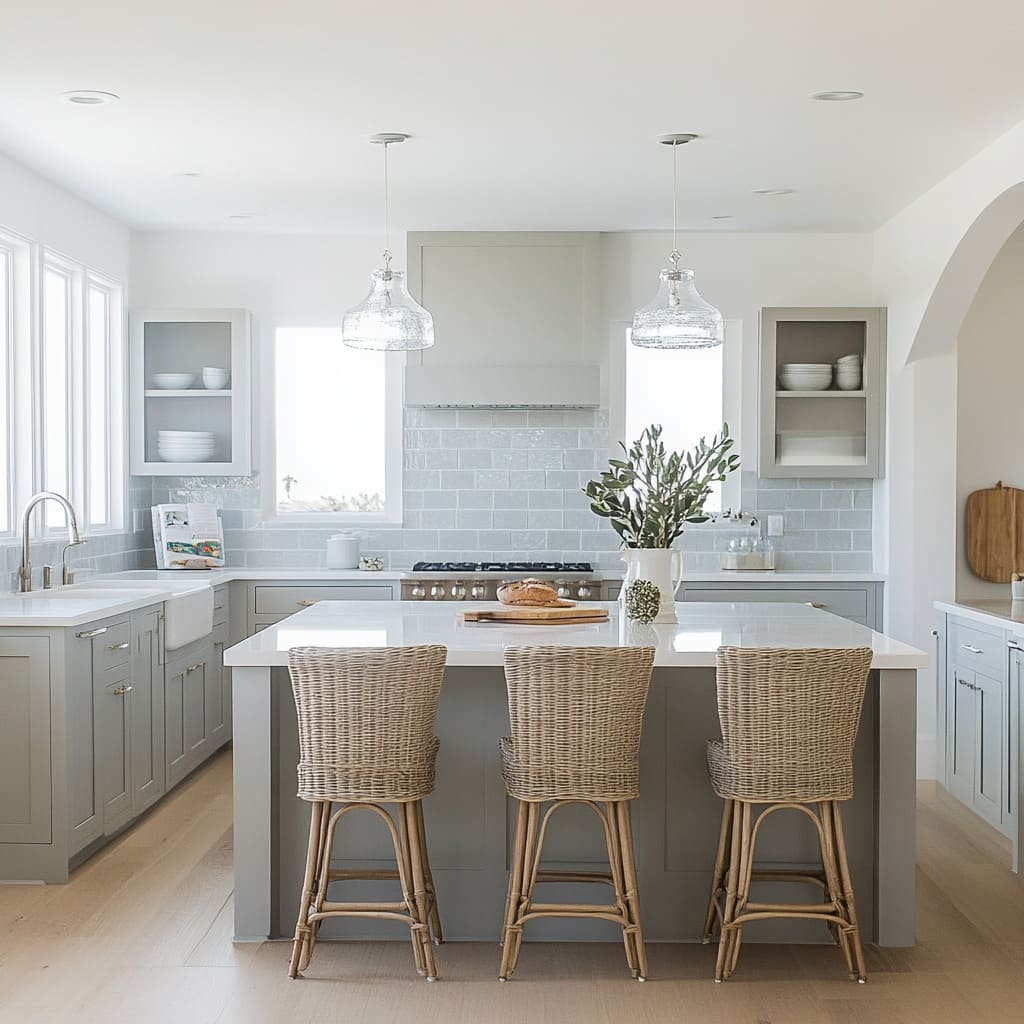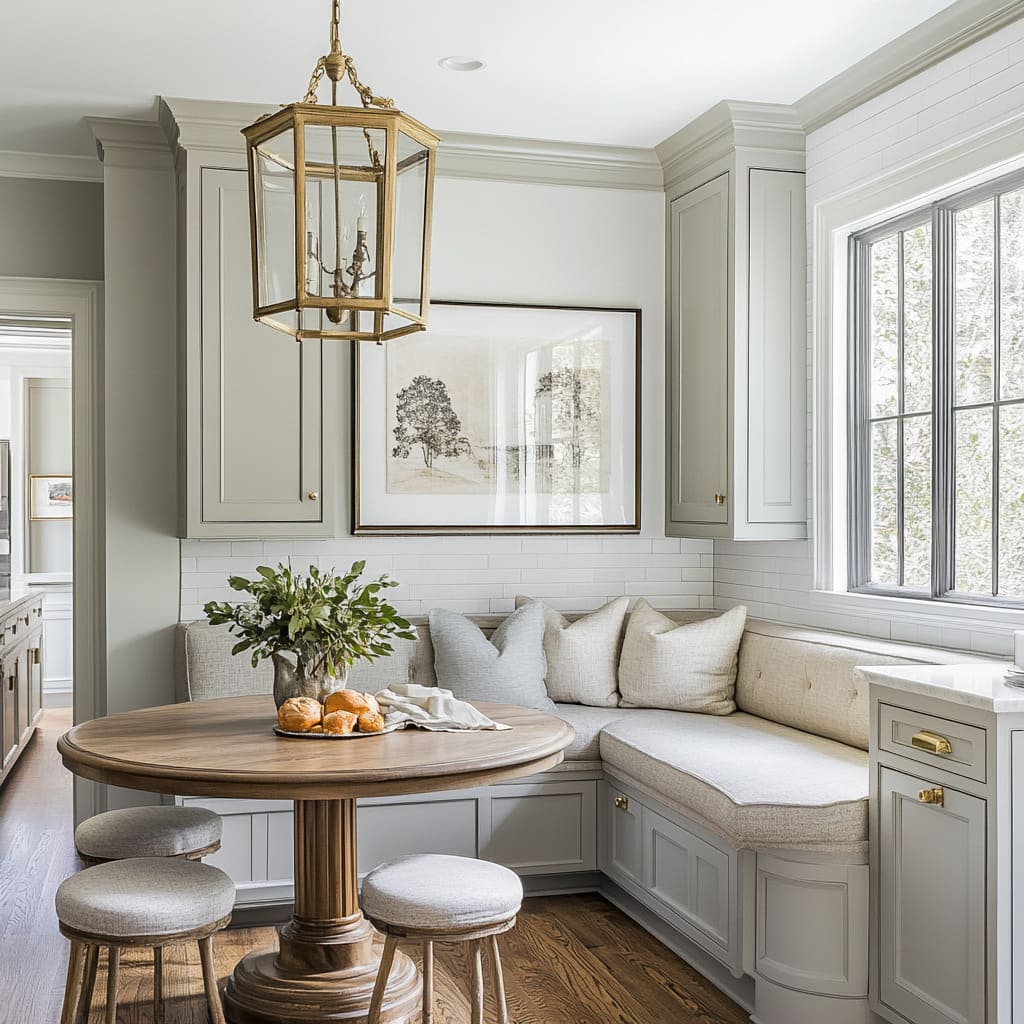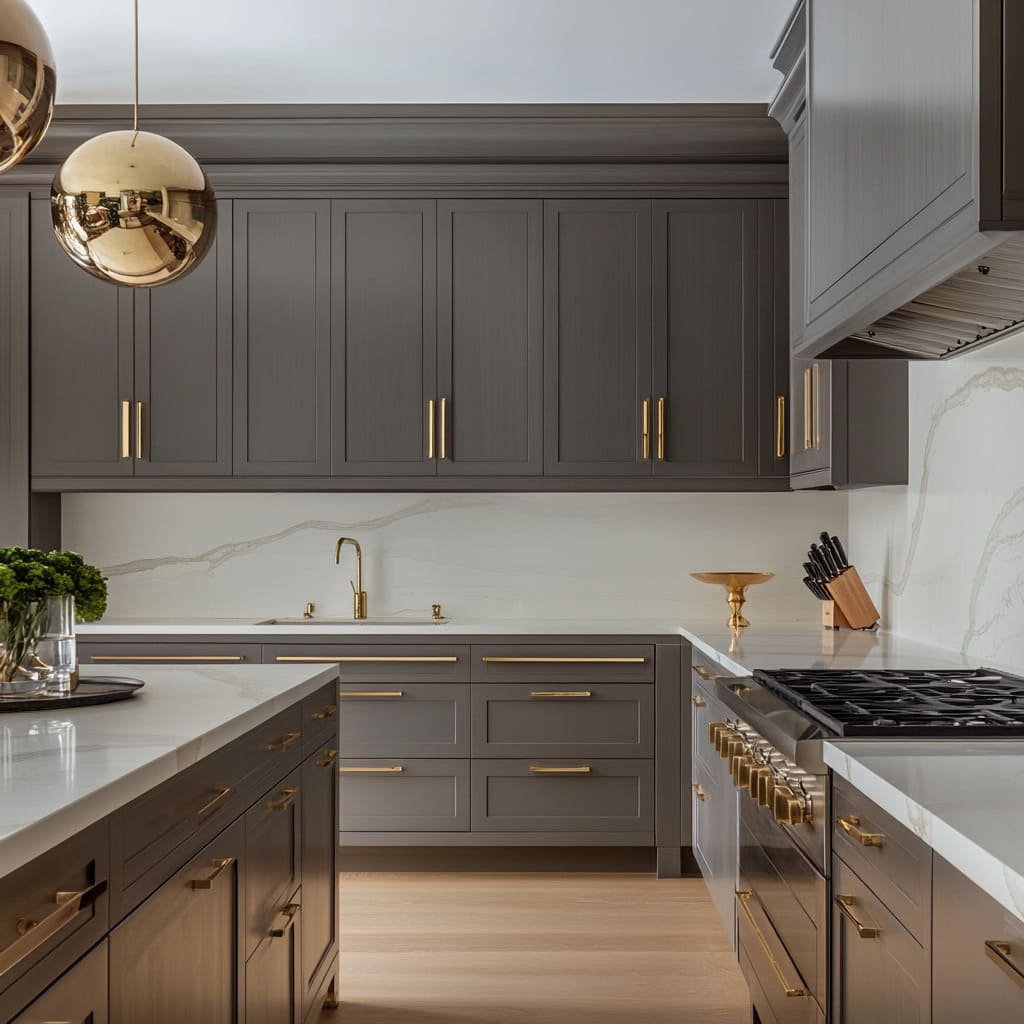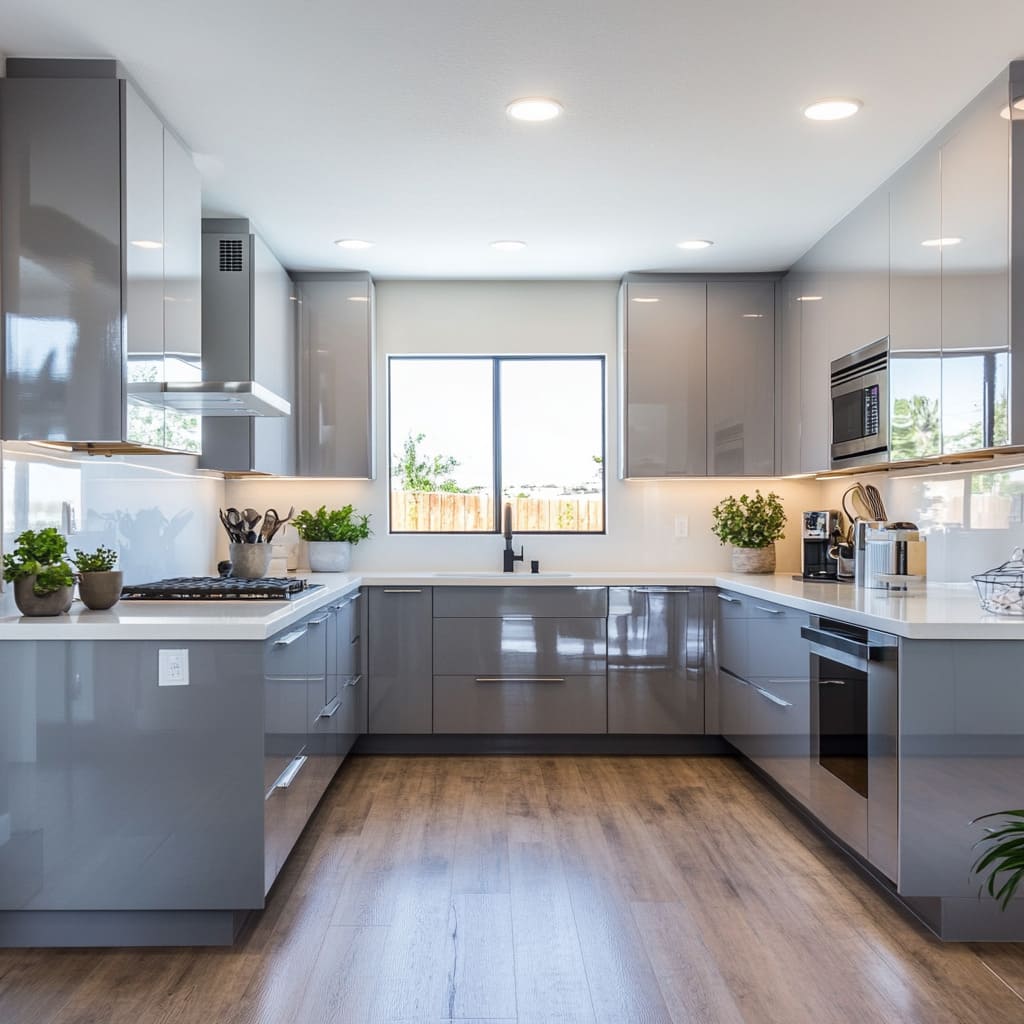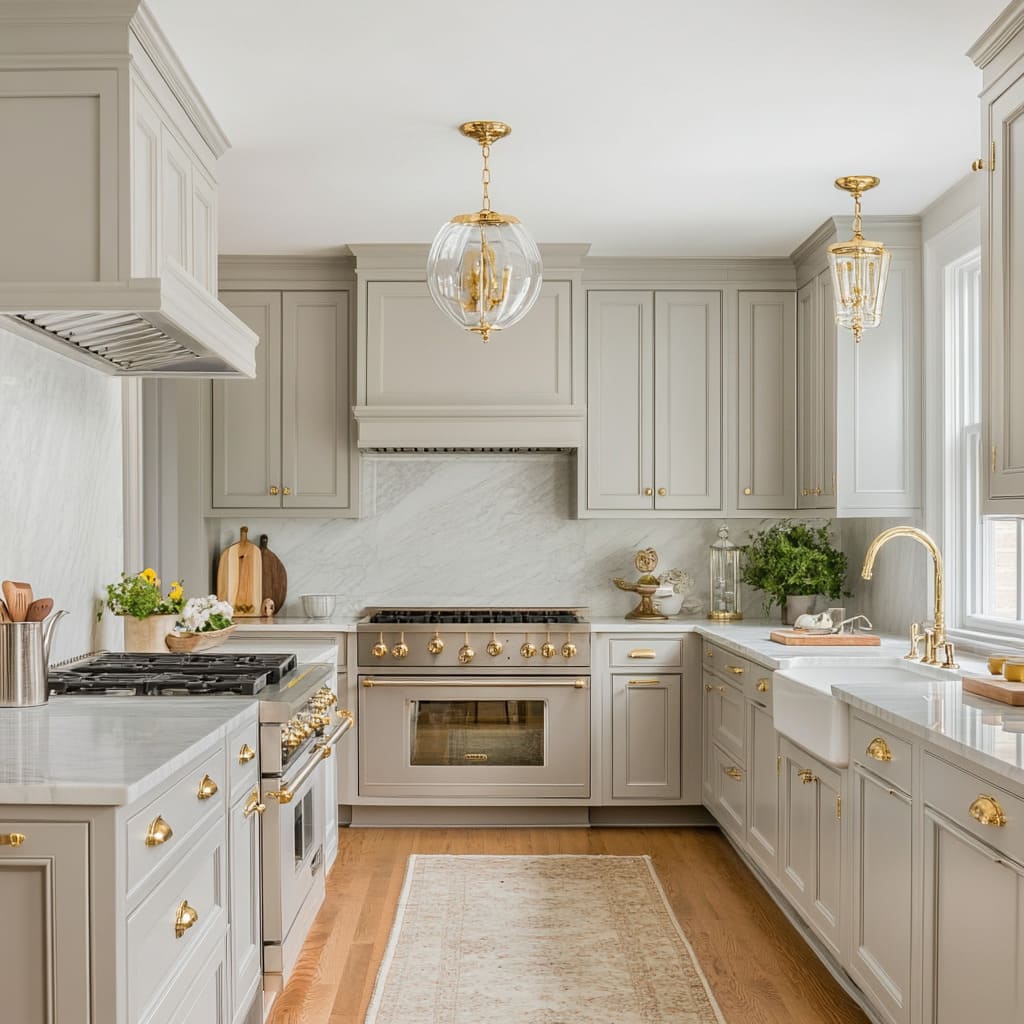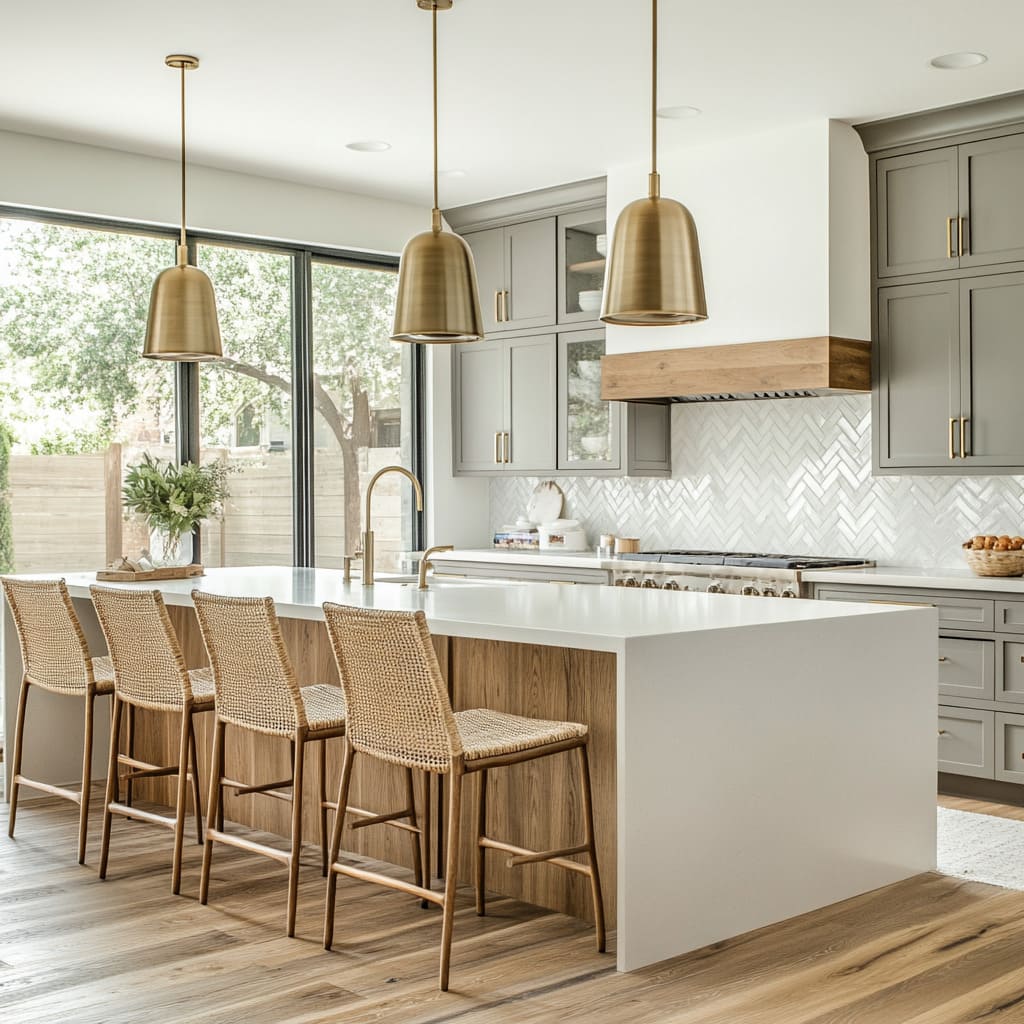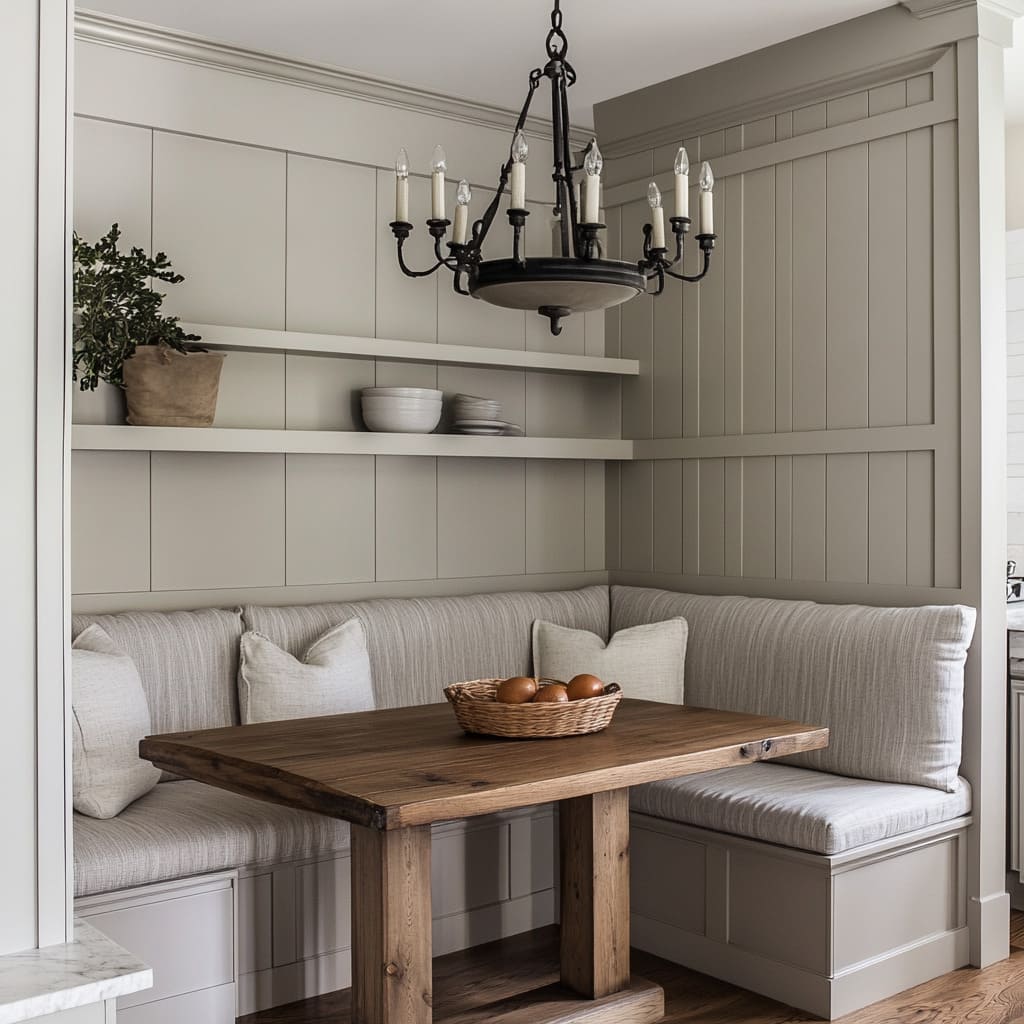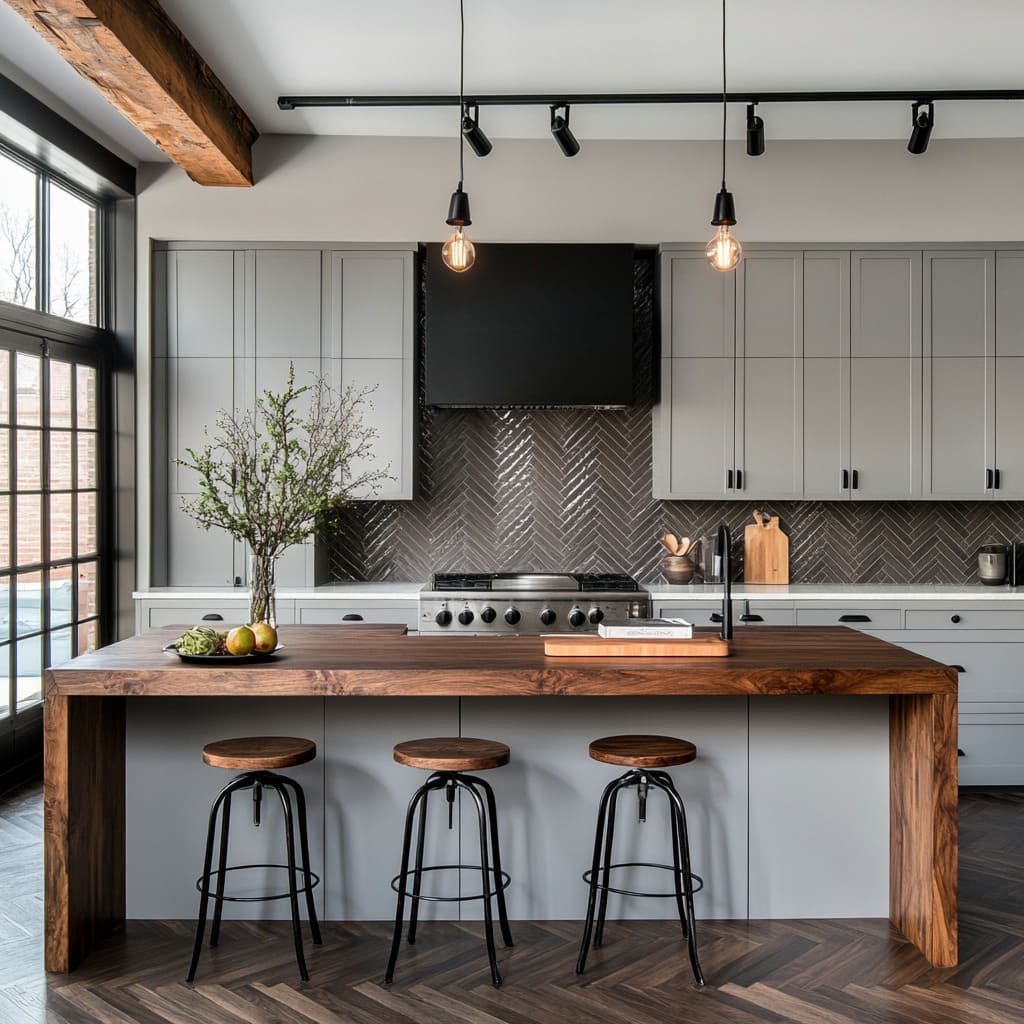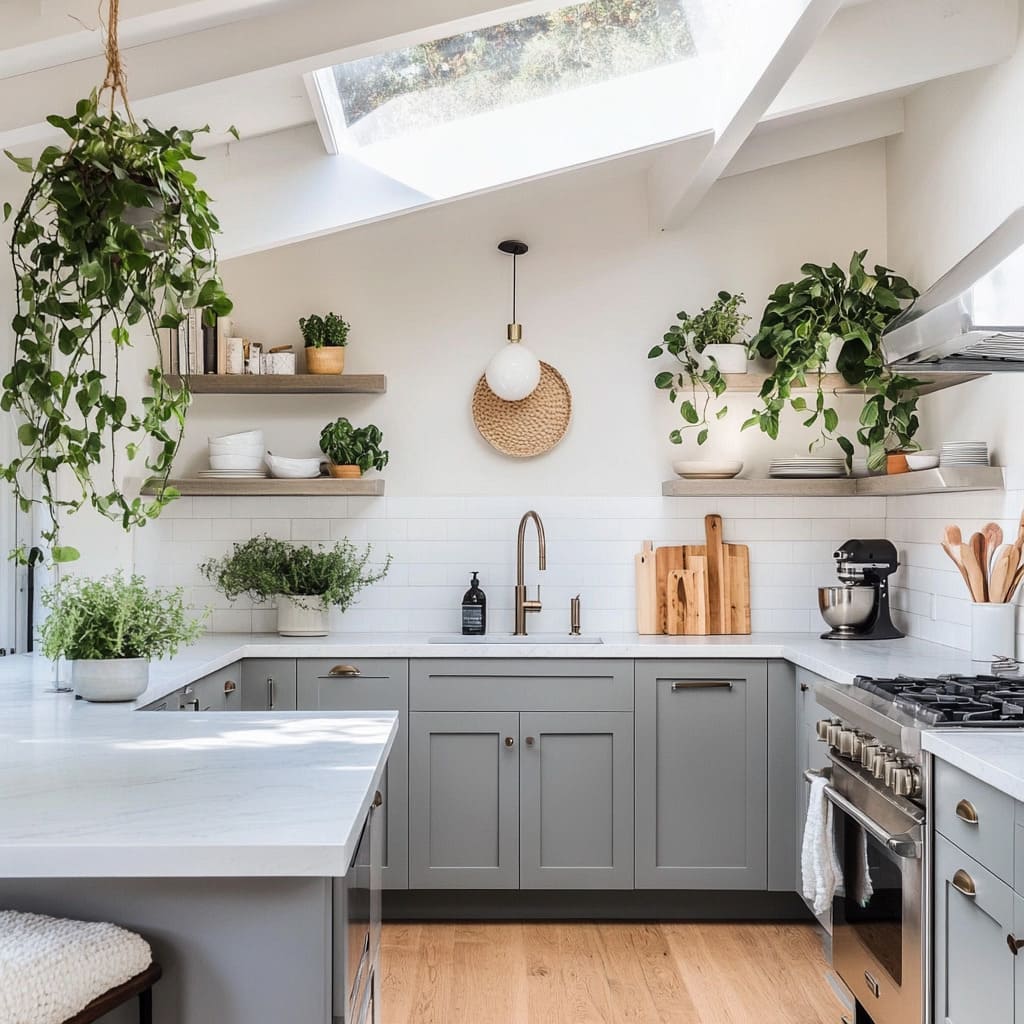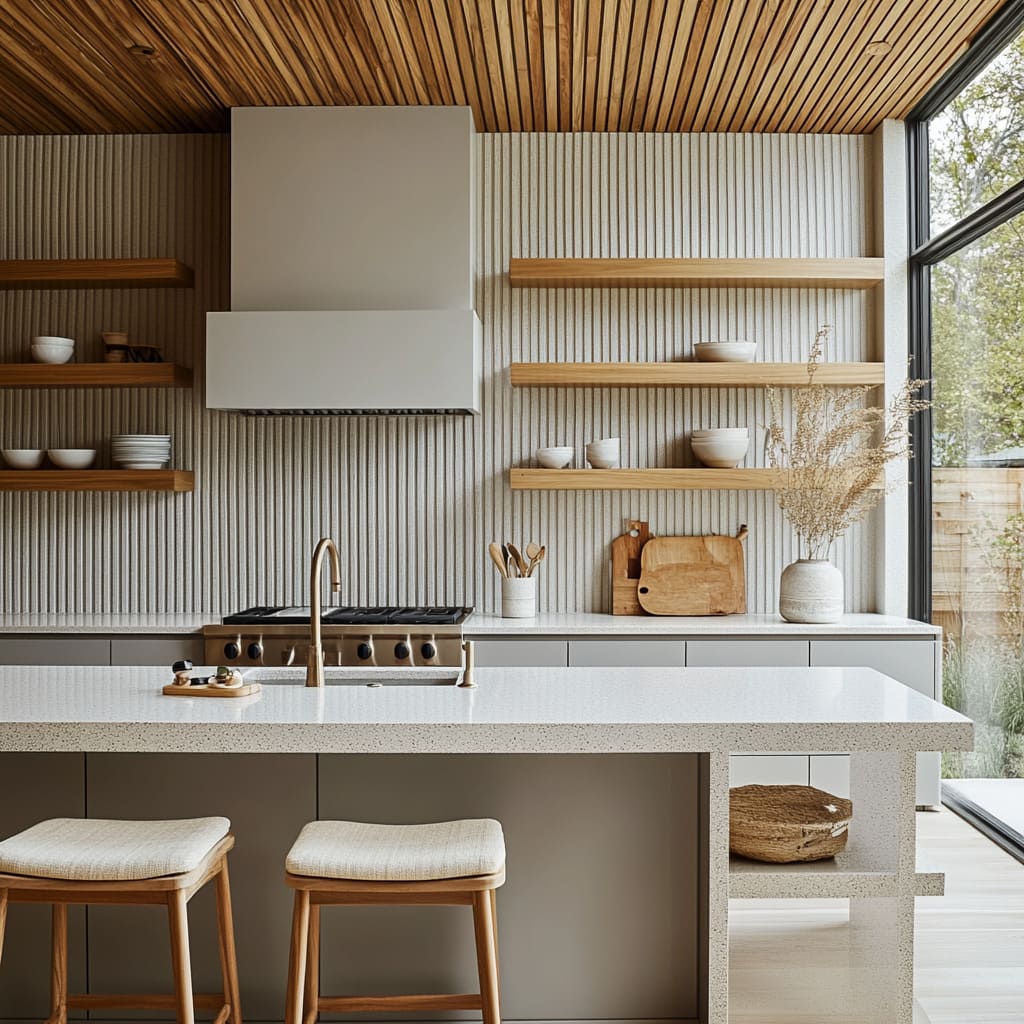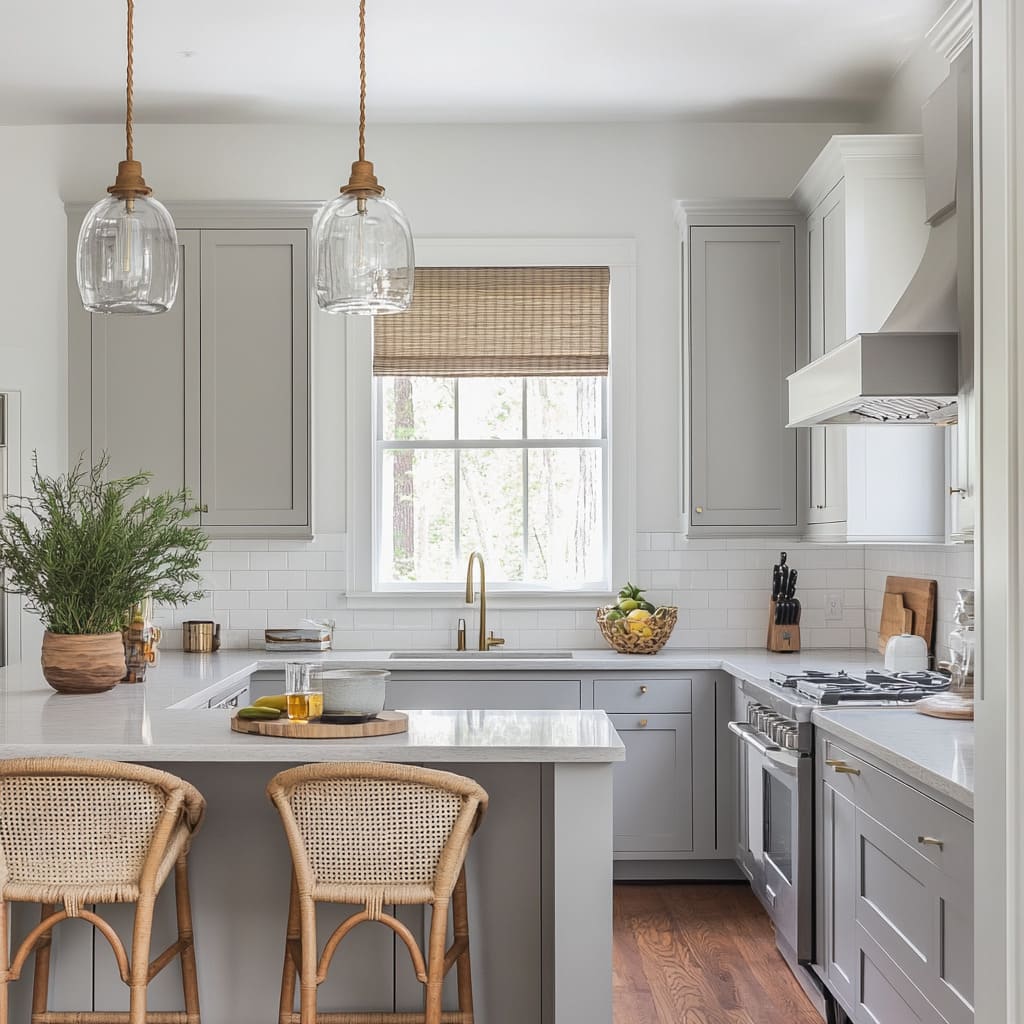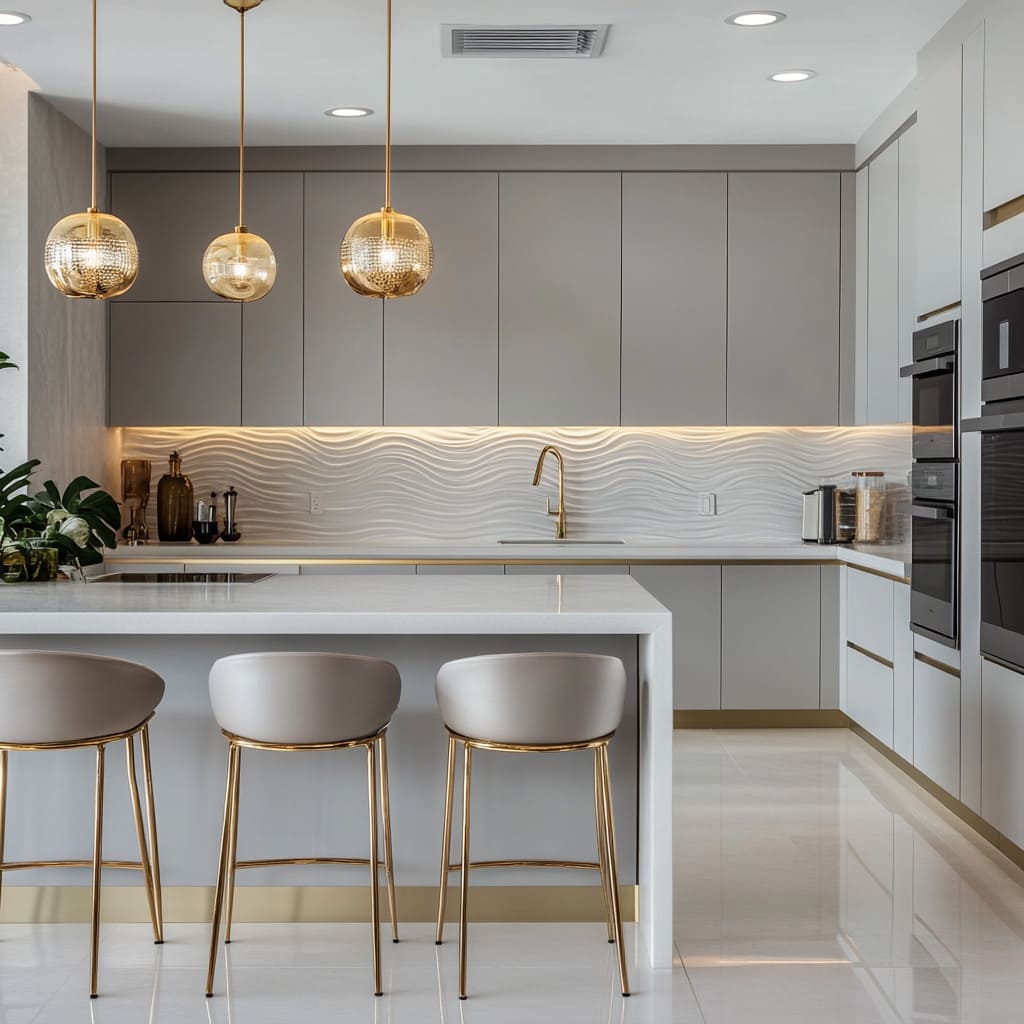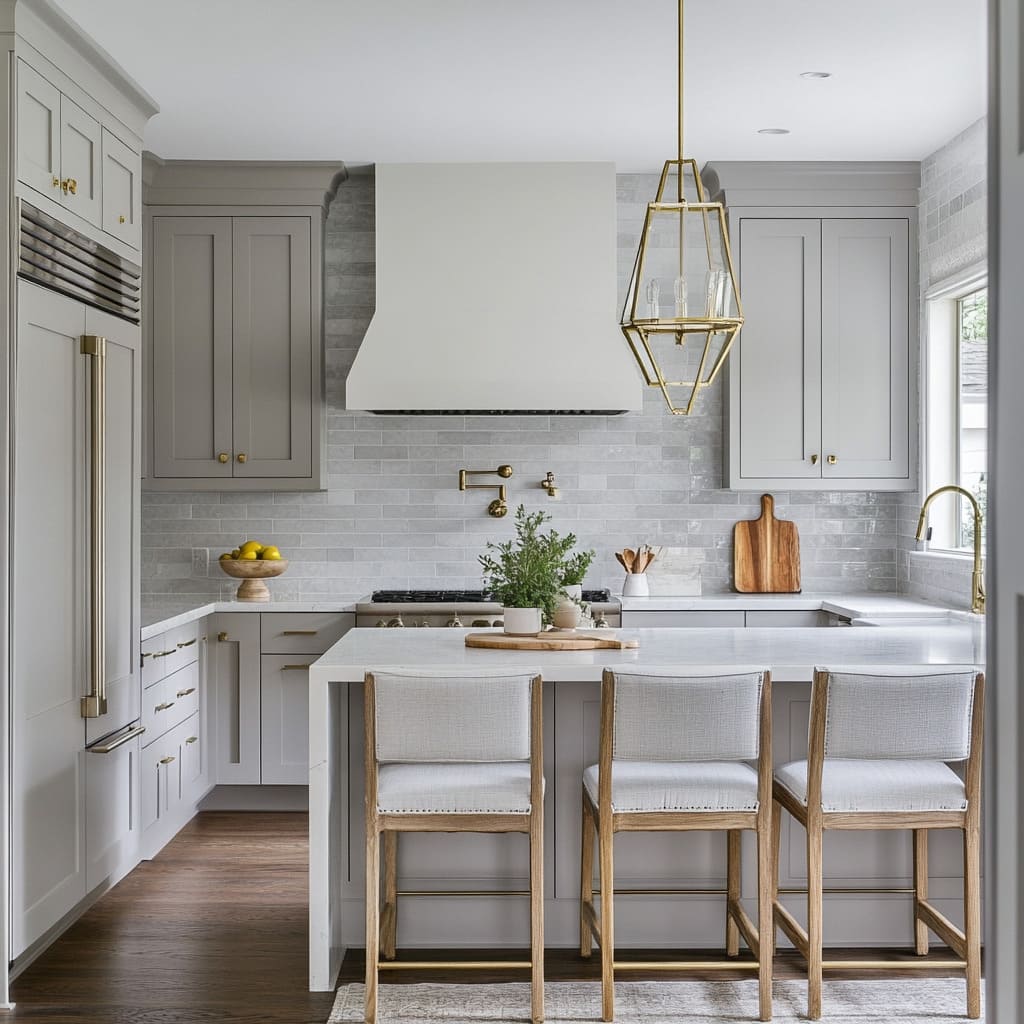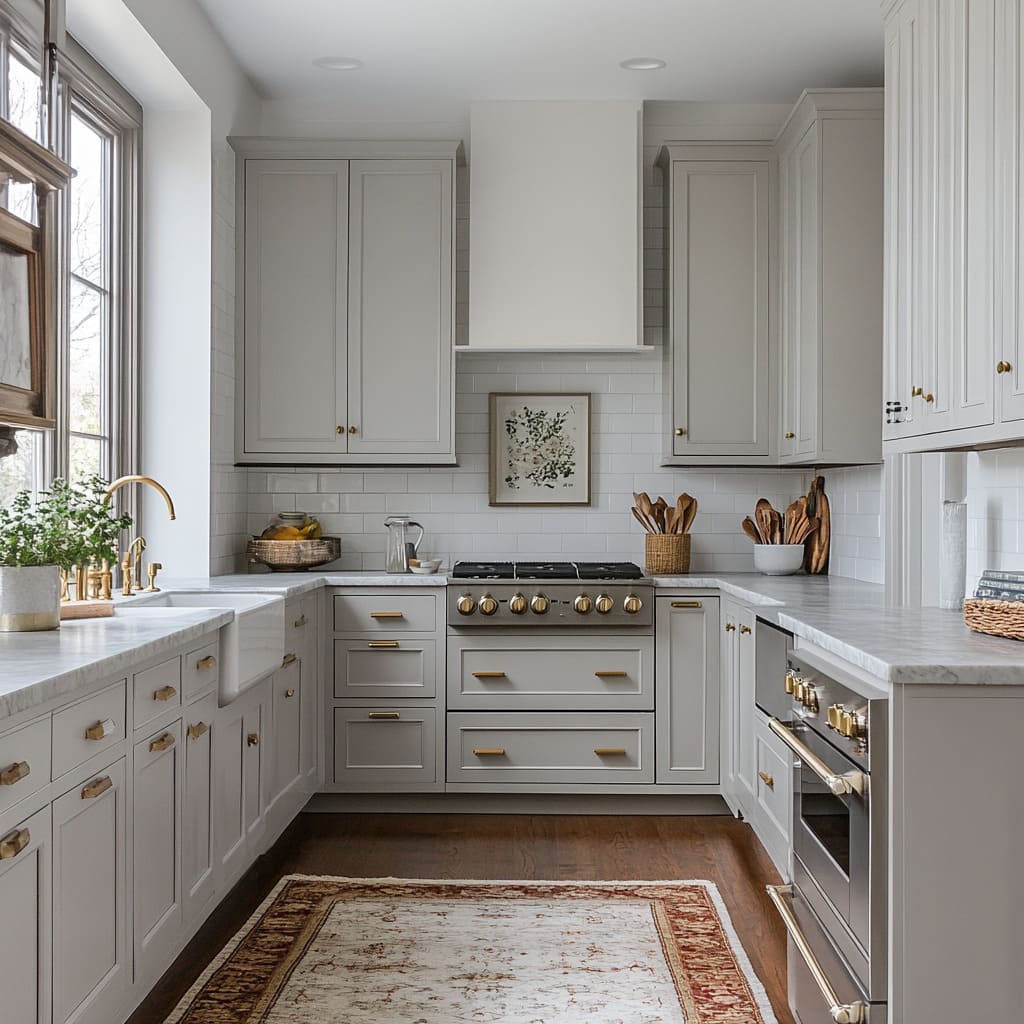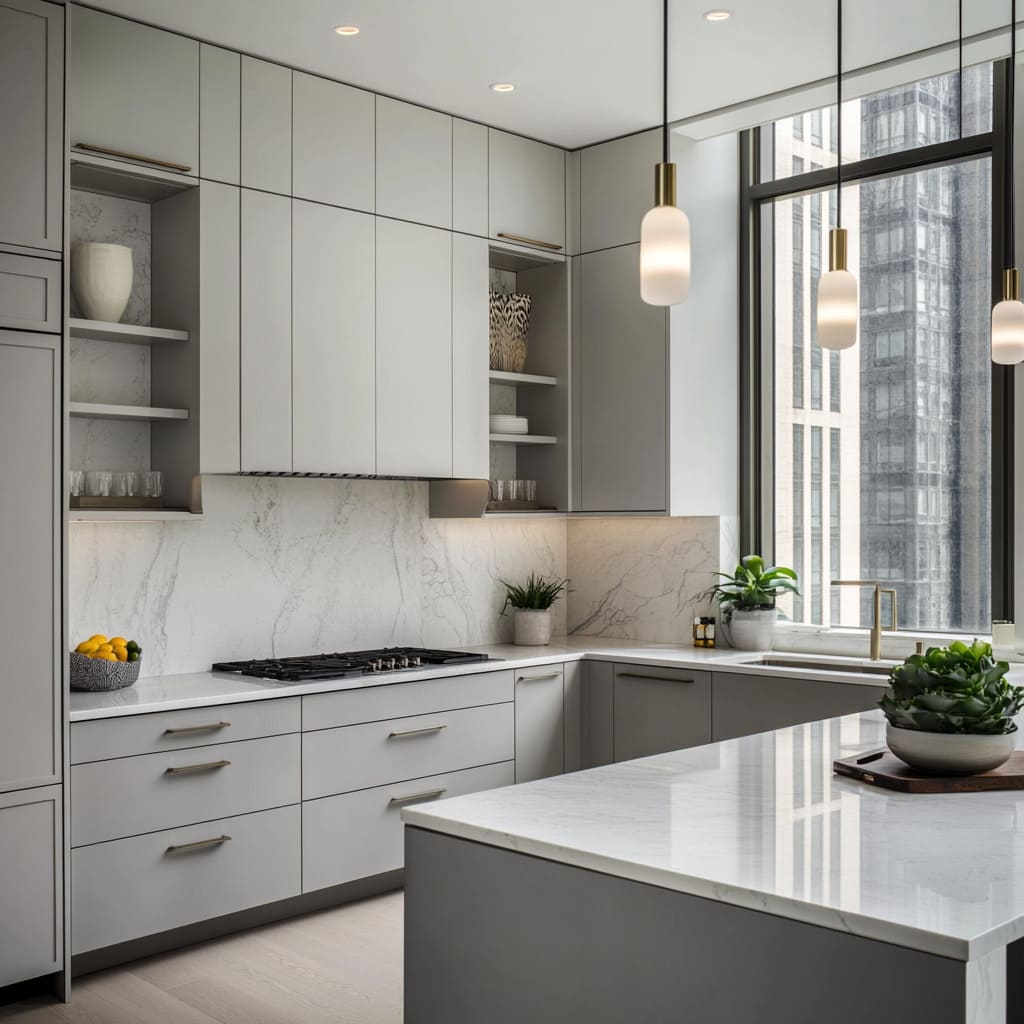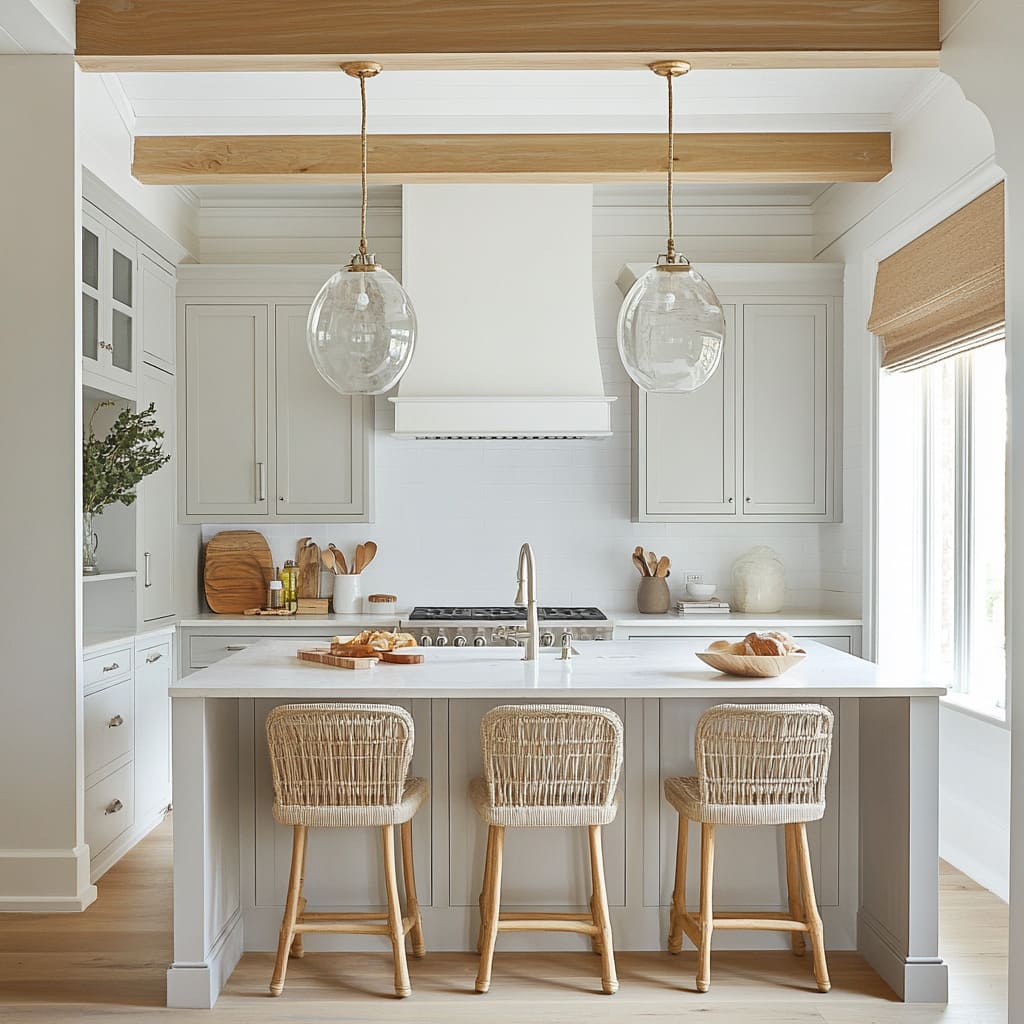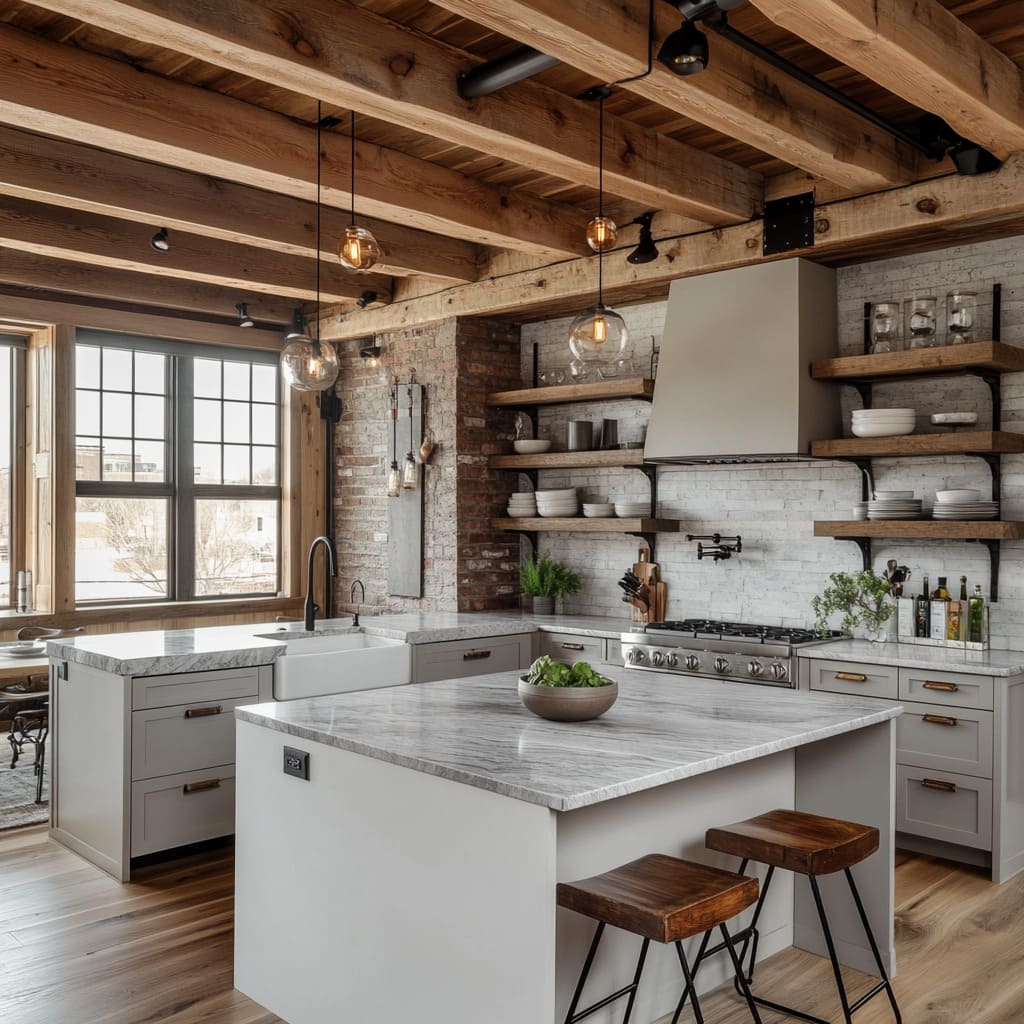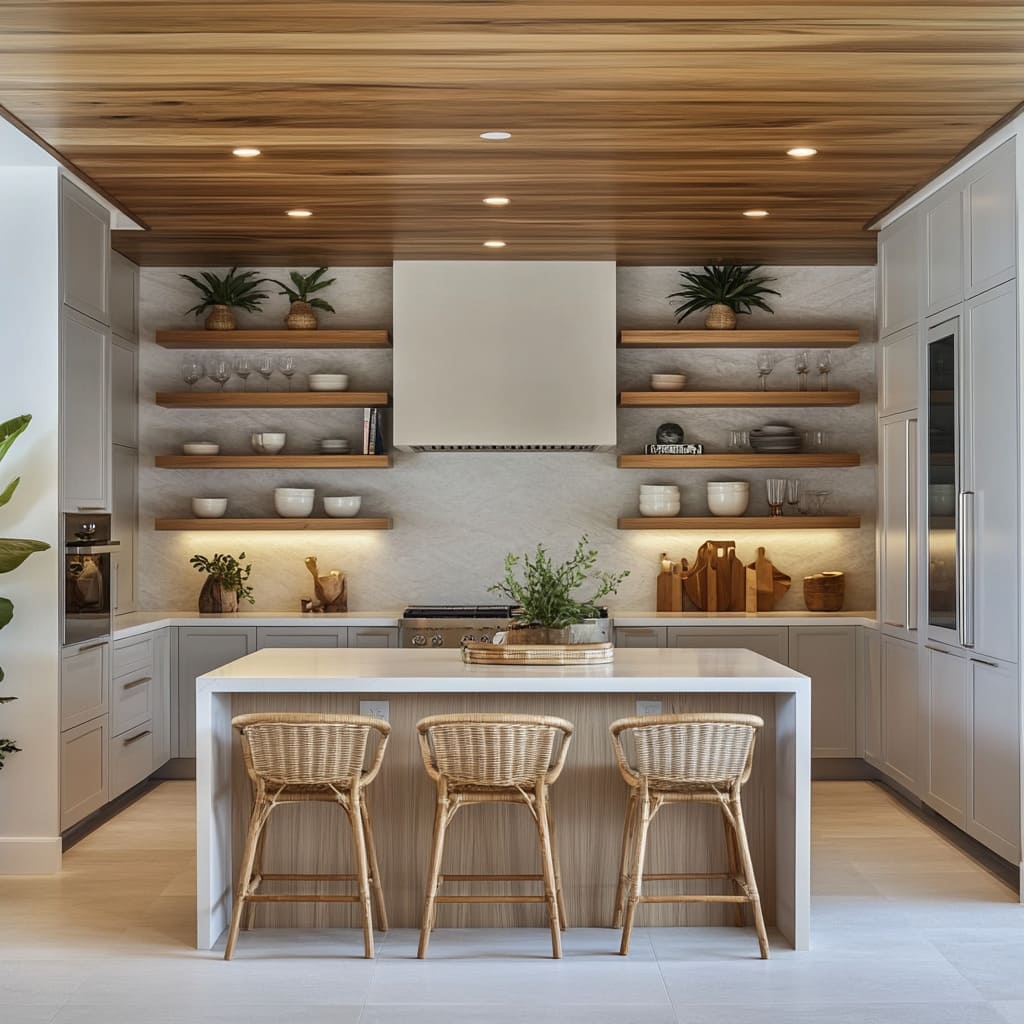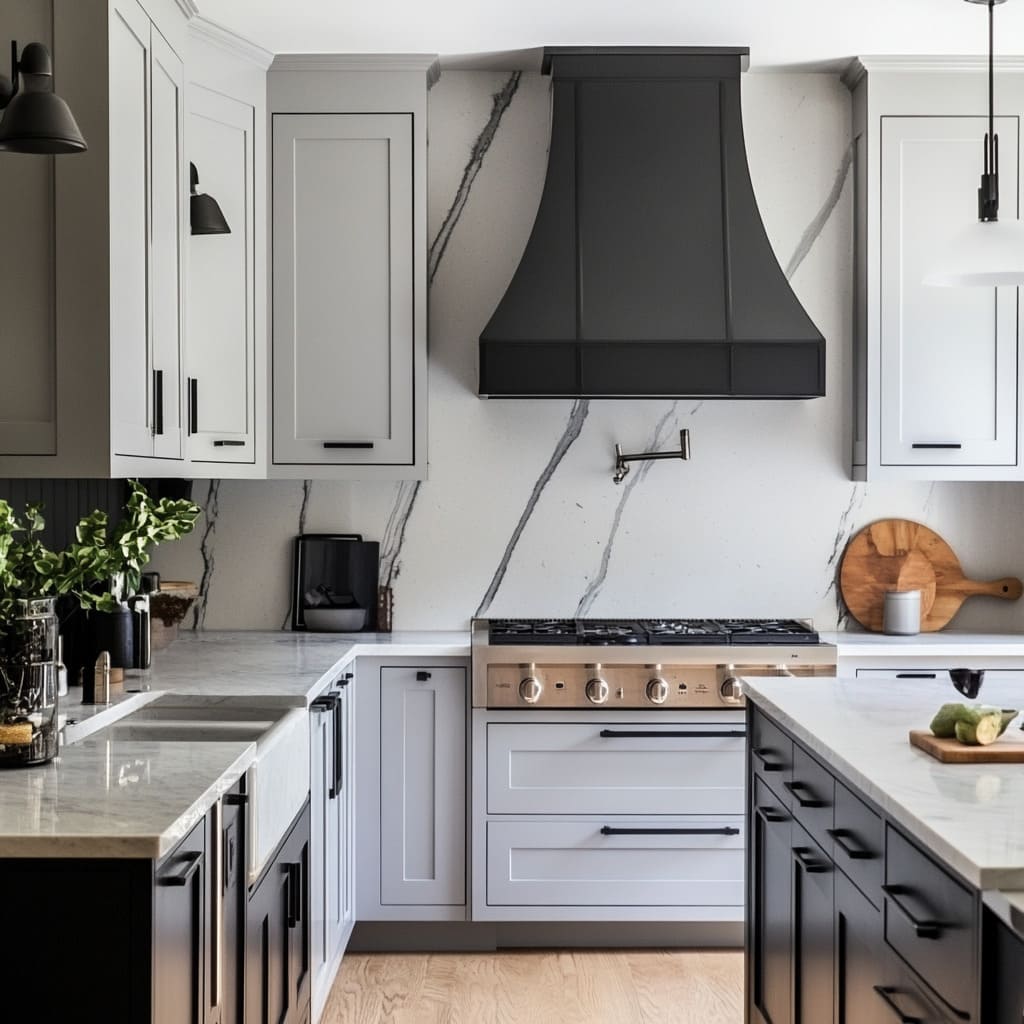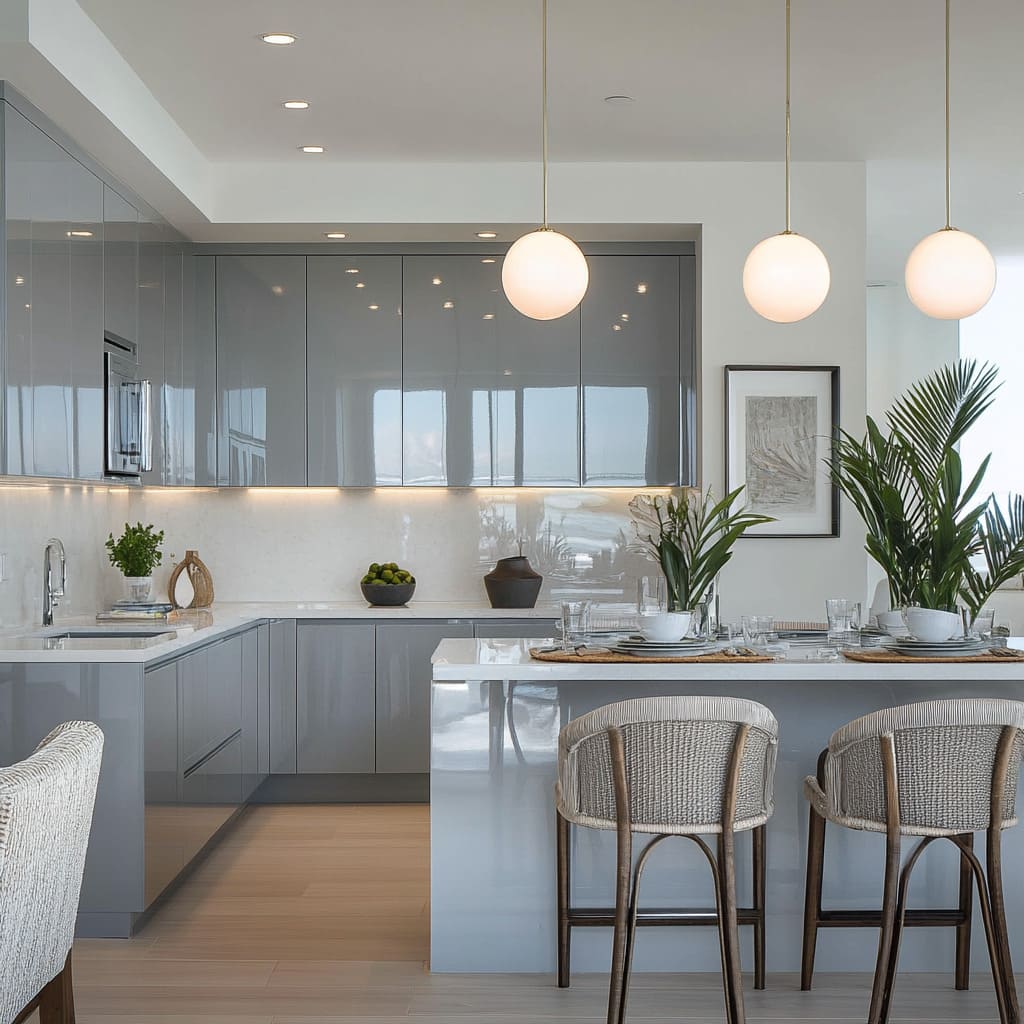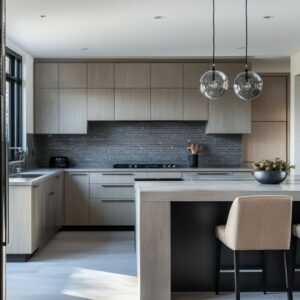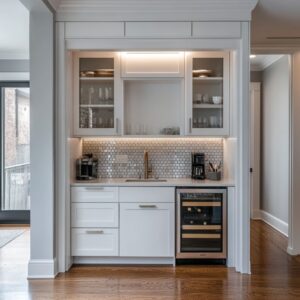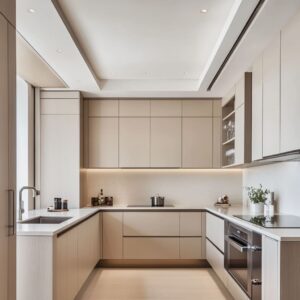A dove grey kitchen offers a versatile and stylish foundation, blending effortlessly with a range of materials, textures, and lighting choices. This color isn’t just about neutrality—it has depth, shifting in tone depending on its surroundings and the time of day.
While many recognize dove grey as a classic choice, there are countless ways to make it feel unique and suited to different kitchen styles. In this article, we go beyond surface-level trends to explore how subtle variations in finish, hardware, and architectural details can influence the overall effect.
Whether you’re working with a compact city kitchen or a spacious open-plan layout, the right combinations can bring out the best in this timeless shade. From warm wood contrasts to sleek modern gloss, these ideas will help you see dove grey in a new light, offering practical ways to shape your space with style and intention.
The Subtle Nuances of Dove Grey in Kitchen Design
Dove grey is more than a standard neutral—it carries subtle shifts in tone that can dramatically change how a kitchen feels. Depending on the lighting, surrounding materials, and finishes, it can appear warm and inviting or cool and sophisticated.
Understanding these shifts is essential for choosing the right variation for your space.
How Lighting Affects Dove Grey
Natural and artificial light play a huge role in how dove grey appears throughout the day. In a sunlit kitchen, cabinets may look softer and more neutral, blending effortlessly with white countertops and light flooring.
As the day progresses, those same cabinets can take on a slightly cooler or warmer hue, depending on whether the sunlight is direct or filtered through curtains. At night, artificial lighting has its own effect.
Warm bulbs bring out hints of taupe or beige, making the space feel cozier, while cooler bulbs highlight blue or grey undertones, creating a crisp and modern look. This is why testing lighting conditions before finalizing your choice is key—you might love a shade in a showroom, only to find it looks completely different in your kitchen.
Reflections and Surroundings
Dove grey isn’t just influenced by light; it also reflects the colors around it. A high-gloss finish in a modern space might subtly pick up tones from a nearby green plant, a vibrant backsplash, or even the flooring.
On the other hand, a matte finish absorbs more light, making the color appear deeper and more consistent. If your kitchen has bold accent colors—such as navy blue bar stools or a patterned rug—those hues may subtly influence how the grey is perceived.
Choosing the Right Undertone
One of the most common challenges is selecting the right shade of dove grey. While some variations have a cooler, blue-tinted base, others lean warmer with hints of beige or taupe.
The best way to avoid surprises is to test large swatches of your chosen color in your actual space. Place them near different surfaces—like your countertops, backsplash, and flooring—and observe them under different lighting conditions.
Making It Work for Your Kitchen
If you’re drawn to dove grey kitchen ideas, consider how the color will interact with your space’s natural and artificial lighting, as well as your existing finishes. In a room with limited daylight, a soft satin or high-gloss finish can help reflect light and keep the space from feeling too dim.
In a bright, open-concept kitchen, a matte finish might be the perfect choice to create a more grounded, inviting atmosphere. The beauty of dove grey is in its adaptability.
Whether paired with warm wood tones for a cozy feel or mixed with sleek metal accents for a contemporary touch, it provides a flexible backdrop that can shift in tone without ever feeling outdated.
How Texture and Finish Influence a Kitchen’s Look and Feel
A color might set the tone for a kitchen, but texture and finish define how it interacts with the space. In warm grey kitchens, the choice between matte, satin, or high-gloss can completely transform the atmosphere, making a kitchen feel more rustic, refined, or sleek.
The right combination of texture and finish can also help balance the light, highlight architectural details, and bring depth to the design.
The Impact of Different Finishes
A single shade of grey can take on entirely different characteristics depending on how it’s applied. Matte cabinets create a soft, understated look, while high-gloss versions add a reflective quality that brightens the space.
Satin, sitting between the two, is a versatile choice that provides just enough light reflection without feeling overly polished.
- Matte Finish: Ideal for spaces with a classic or organic feel. It absorbs light, making the color appear deeper and more grounded. This finish works particularly well in kitchens with exposed wood elements, textured tiles, or handcrafted details. Since matte surfaces don’t reflect light, they’re excellent for open spaces where too much shine could feel overwhelming.
- Satin Finish: A practical middle ground. It offers a hint of reflection while maintaining a smooth, clean appearance. It’s a great choice for kitchens where balance is key, such as transitional designs that blend modern and traditional elements.
- High-Gloss Surface: The best option for contemporary or minimalist kitchens. Its reflective nature enhances brightness, making smaller spaces feel more open. However, gloss finishes require more maintenance, as fingerprints and smudges tend to stand out more.
How Texture Changes the Effect
Beyond the finish, adding texture can bring another layer of depth to a grey kitchen. Brushed metal trims, patterned backsplashes, and wood grain details help break up large areas of smooth cabinetry, ensuring the space doesn’t feel too uniform.
Even a subtle grain in wood cabinets or a slightly textured stone countertop can shift the overall perception of the design.
Choosing the Right Finish for Your Space
A kitchen’s size, lighting, and layout all influence which finish will work best. If the space is compact and lacks natural light, satin or gloss finishes can help reflect light and create a more open feel.
In larger kitchens with high ceilings, a matte finish can add warmth and prevent the space from feeling too stark. By carefully selecting textures and finishes, a warm grey kitchen can feel inviting, stylish, and perfectly suited to the overall aesthetic of the home.
The Power of Metal Accents in a Dove Grey Kitchen
The softness of dove grey kitchen cabinets provides the perfect backdrop for striking metal accents. Whether it’s the warm glow of brass, the bold contrast of black hardware, or the sleek neutrality of stainless steel, these details shape the overall look of the space.
The right metal finish doesn’t just complement the cabinetry—it defines the atmosphere, adding a layer of visual interest without overpowering the design.
Finding the Right Metal Finish
The choice of metal can dramatically shift the personality of a kitchen. Some finishes add warmth, while others create a sharp contrast, making the dove grey feel even more refined.
- Brass and Gold: These metals bring a touch of warmth, preventing the cabinetry from feeling too cool or sterile. High-polish brass gives a more reflective, statement look, while an aged or brushed finish keeps things understated. This pairing works beautifully in both classic and modern spaces, adding a hint of richness without feeling excessive.
- Black or Graphite: For a striking contrast, black hardware or fixtures sharpen the look of grey cabinetry. Matte black handles, light fixtures, or window frames create depth, giving the kitchen a more structured, architectural feel. This works especially well in spaces that lean toward industrial or contemporary styles.
- Stainless Steel: If the goal is a seamless, neutral look, stainless steel blends effortlessly. It doesn’t compete with the cabinetry, allowing other design elements—like backsplashes or countertops—to take center stage. Stainless steel is also a practical choice for those who prefer a timeless, low-maintenance option.
Mixing Metals Without Overcomplicating the Design
It’s possible to mix different metal finishes, but the key is balance. Choosing one dominant metal while introducing a secondary finish in small details—such as cabinet pulls or light fixtures—keeps the space cohesive.
For example, a kitchen with brushed brass hardware can still incorporate black-framed windows or stainless steel appliances without looking mismatched. These subtle contrasts bring out the beauty of dove grey, making the cabinetry feel dynamic rather than flat.
Whether the goal is warmth, contrast, or a seamless modern touch, metal accents shape the final impression, turning simple cabinetry into something far more refined.
Bringing Warmth and Texture to a Dove Gray Kitchen
A dove gray kitchen creates a perfect canvas for natural elements to shine. This neutral shade adapts easily to its surroundings, shifting in tone based on the textures and materials it’s paired with.
While dove gray has a reputation for being soft and understated, introducing organic elements—such as wood, woven materials, and stone—can add richness and depth, preventing the space from feeling flat or overly uniform.
How Natural Materials Influence the Look
The beauty of dove gray lies in its ability to take on a different personality depending on the surrounding finishes. Whether the goal is a warm, inviting space or a cooler, more refined aesthetic, the right mix of textures can create balance.
Wood Accents for Warmth
Light oak floors, exposed beams, or butcher-block countertops highlight the cooler side of dove gray, creating a soft contrast that keeps the space from feeling too cold. In kitchens with darker cabinets, walnut or richly stained wood brings an elegant touch, adding visual weight without overwhelming the design.
Rattan and Woven Details for a Casual Touch
Bar stools with woven seats, light fixtures wrapped in natural fibers, or even a simple rattan tray can introduce a relaxed, layered look. This works especially well in kitchens inspired by coastal, farmhouse, or bohemian styles, where natural textures soften the cabinetry’s clean lines.
Stone Surfaces for Depth and Movement
A solid color kitchen can sometimes feel too uniform, but adding a marble or quartz countertop with visible veining can introduce natural variation. The subtle patterns in stone backsplashes or countertops create an organic contrast that enhances the dove gray’s softness without overpowering it.
Striking the Right Balance
If the kitchen leans too cool, adding warm-toned wood, woven accents, or brass hardware can soften the space. On the other hand, if it feels too warm, introducing cooler materials—like white marble, concrete, or black metal details—can create a more refined balance.
The key to making a dove gray kitchen feel dynamic is in the mix of textures. A blend of smooth and rough, matte and polished, warm and cool creates a layered look that feels inviting and timeless.
How Lighting Transforms a Dove Grey Kitchen
Lighting can completely change the way a kitchen looks and feels, and in a space with dove grey cabinetry, the right fixtures and bulb temperatures can make all the difference. This shade shifts throughout the day, taking on cooler or warmer tones depending on natural and artificial light.
A thoughtful lighting plan doesn’t just brighten a space—it enhances depth, highlights texture, and brings out the best in every surface.
The Role of Different Light Temperatures
The warmth or coolness of a bulb can alter how dove grey appears. Warm white (2700K-3000K) bulbs bring out beige or taupe undertones, making the space feel inviting and cozy.
Cool white (4000K-5000K) bulbs, on the other hand, enhance the crispness of the grey, giving the kitchen a more modern, polished look. In kitchens that receive limited natural light, mixing both temperatures helps balance the space, ensuring the cabinetry never looks too dull or overly stark.
Choosing the Right Fixtures
Pendant Lights as Focal Points
Over an island or dining space, pendant lights add character while influencing how the cabinetry looks. Rounded glass pendants soften the structured lines of cabinets, while metal fixtures in brass or matte black can introduce contrast.
In kitchens with industrial influences, exposed filament bulbs bring a raw, unfinished charm, while frosted globes create a softer, diffused glow.
Under-Cabinet Lighting for Subtle Effects
Installing LED strips beneath upper cabinets not only provides functional task lighting but also changes how dove grey is perceived. A warm-toned strip makes the cabinetry look richer, while a cooler-toned one enhances the crispness of the color.
This hidden lighting detail also prevents shadows from making the space feel darker than it actually is.
Recessed and Ceiling-Beam Lighting for a Layered Look
In rustic or loft-style kitchens, integrating lighting within wooden beams can create a gentle, indirect glow. Recessed lighting, when placed strategically, eliminates harsh shadows and helps distribute illumination evenly.
This technique works well in kitchens where dove grey cabinetry is paired with wood accents, as it enhances both materials without overpowering either.
Creating the Right Atmosphere
A single light source isn’t enough to bring out the full depth of a dove grey kitchen. Layering multiple types of lighting—such as overhead pendants, under-cabinet LEDs, and recessed fixtures—adds dimension and flexibility.
Dimmer switches allow for even more control, making it possible to adjust brightness levels based on time of day or mood. By choosing the right lighting elements, a dove grey kitchen can feel warm and inviting or sleek and modern, adapting effortlessly to the surrounding design and personal style.
Adding Depth to Grey Kitchens with the Right Accent Colors
A grey kitchen is a timeless choice, but introducing the right accent colors can shift the overall feel—making the space feel soft and airy, bold and dramatic, or warm and inviting. Whether through small decorative touches or larger design elements, the right color balance ensures the kitchen stays visually interesting while maintaining its neutral foundation.
How Different Colors Influence the Look
Grey acts as a flexible backdrop, allowing different accent shades to take center stage without overwhelming the space. The choice of colors depends on the mood you want to create.
Soft Pastels for a Light and Airy Feel
Shades like mint, blush, or pale blue create a calming effect, enhancing the gentle quality of grey. These colors work especially well in kitchens with a lot of natural light, where they can brighten the space without competing with the cabinetry.
Incorporating pastels in upholstered bar stools, dishware, or even a backsplash can subtly lift the room’s atmosphere.
Deep Jewel Tones for a Bold Contrast
Navy, emerald, and even deep burgundy introduce richness and depth, providing a striking contrast against grey cabinetry. Since these shades can be quite intense, they work best when used in small doses—such as on a feature wall, in pendant lights, or through accent pieces like vases or seating.
This approach adds drama without overwhelming the space.
Earthy Tones for a Grounded, Cozy Look
Shades like olive green, terracotta, or mustard yellow complement the natural warmth in certain shades of grey. These colors pair especially well with kitchens that have wooden elements, bringing in a relaxed, inviting feel.
Open shelving with earth-toned ceramics, a warm-toned tile backsplash, or simple linen curtains can introduce these hues in a way that feels natural and balanced.
Finding the Right Balance
For those who prefer to keep the kitchen mostly neutral, subtle accent colors can still add variety without dominating the space. A few key elements—such as textiles, a statement rug, or even cabinet hardware—can shift the overall impression without requiring a major design change.
By thoughtfully incorporating accent colors, a grey kitchen can feel fresh and layered rather than monochromatic. Whether aiming for a modern contrast or a softer, more natural look, these subtle touches help create a space that feels intentional and inviting.
Adapting a Grey Kitchen to Different Layouts and Spaces
A warm gray kitchen can be tailored to suit any home, whether it’s a compact urban space or a sprawling open-plan layout. The way grey interacts with lighting, materials, and architectural details shifts depending on the environment, so choosing the right approach is key to making the space feel balanced and inviting.
Here’s how to make grey work in different kitchen settings.
Small Galley Kitchen
In a narrow space, grey can either open up the room or make it feel closed in, depending on the finish and layout choices.
- Use of Gloss or Satin: Reflective cabinetry or glossy tiles help bounce light, preventing the space from feeling cramped.
- Minimal Hardware: Opt for sleek, concealed handles or push-to-open cabinets to reduce visual clutter.
- Strategic Lighting: Under-cabinet LED strips create a sense of depth and keep the kitchen feeling bright and airy.
Large, Open-Plan Kitchen
An expansive space benefits from layering materials and defining zones to avoid a flat, monotonous look.
- Island as a Focal Point: Painting the island in a slightly different shade—either lighter or darker than the main cabinetry—creates a subtle contrast.
- Mixed Materials: Combining grey with wood, metal, or stone prevents the space from feeling too uniform. This can be done through flooring, shelving, or statement backsplashes.
- Statement Lighting: Oversized pendant lights or sculptural fixtures above the island help break up high ceilings and add personality.
Low-Natural-Light Kitchen
If a kitchen lacks windows or receives minimal daylight, the right shades and finishes can prevent it from feeling too dim.
- Opt for Lighter Shades of Dove Grey: Deeper greys can make a dark kitchen feel enclosed, while a softer shade brightens the space.
- Warm Bulbs and Layered Lighting: Using multiple light sources—such as recessed lights, pendants, and under-cabinet LEDs—ensures the room feels well-lit and inviting.
- Reflective Backsplash: A high-gloss or mirrored backsplash enhances brightness by reflecting available light.
High-Ceiling Kitchen with Rustic Features
A grey kitchen in a space with tall ceilings and exposed beams needs a careful balance of color and texture to feel cozy rather than cavernous.
- Deeper Matte Grey: A rich, matte grey grounds the space and prevents it from feeling too expansive.
- Timber Elements: Wooden beams, open shelving, or butcher-block countertops introduce warmth and contrast against the cool grey.
- Industrial Metal Accents: Black or wrought-iron hardware and light fixtures add contrast and structure without overpowering the natural elements.
By adapting materials, finishes, and lighting to the specific kitchen layout, a grey palette can work in any setting—making the space feel comfortable, stylish, and perfectly suited to its surroundings.
Small Details That Bring a Warm Gray Kitchen to Life
Even the most carefully designed kitchen can feel incomplete without the right finishing touches. A warm gray kitchen provides a neutral base, but small extras—like artwork, textiles, and natural elements—can add personality, warmth, and a sense of balance.
These details may seem minor, but they play a huge role in tying the entire space together.
Artwork and Wall Decor for Depth
Bare walls in a kitchen can sometimes feel too stark, especially when working with a neutral palette. A framed botanical print above the stove or an abstract piece on a feature wall can break up large expanses of cabinetry, bringing in a soft contrast to the grey tones.
If the kitchen has open shelving, a carefully placed decorative plate or sculptural object can act as an understated focal point.
Textiles and Rugs for Softness
Adding texture through textiles helps prevent a grey kitchen from feeling too flat. A woven runner near the sink, a patterned rug beneath the island, or even linen bar stool cushions introduce subtle warmth.
Choosing fabrics with hints of grey, gold, or earthy tones ensures they blend seamlessly without overpowering the space.
Greenery for a Fresh Contrast
Natural elements bring energy into a kitchen, and greenery is one of the easiest ways to add contrast against grey cabinetry. A potted herb garden on the windowsill, trailing vines on open shelves, or a statement olive tree in the corner adds color while keeping the atmosphere relaxed and inviting.
Even dried flowers in a simple ceramic vase can provide a soft, organic contrast.
Visible Veining in Stone for Movement
A solid grey kitchen can sometimes feel too uniform, but a marble or quartz countertop with natural veining adds movement and depth. The subtle pattern in stone surfaces—whether dramatic or barely there—keeps the overall look dynamic.
Choosing a countertop with warm undertones can also enhance the inviting feel of the space. By incorporating a few well-chosen details, a warm gray kitchen can feel layered and full of character, making the space look thoughtfully designed rather than overly planned.
The Versatility of Dove Grey in Kitchen Design
A dove grey kitchen is anything but one-dimensional. Depending on the surrounding materials, lighting, and finishes, this adaptable shade can create a look that’s soft and inviting or bold and striking.
It can serve as the perfect neutral foundation or become a statement element when paired with contrasting textures and accents. Whether the goal is a rustic, industrial, minimalist, or classic space, dove grey molds itself to the overall vision with ease.
When designing a kitchen in this color, it’s important to think beyond just the cabinetry. Undertones play a crucial role in how the shade interacts with flooring, countertops, and hardware.
Warm wood tones can soften the grey, while metal finishes and stone surfaces introduce depth and contrast. Even small additions—such as greenery, bar stools, or a well-placed rug—can shift the overall atmosphere, making the space feel more layered and intentional.
Dove grey’s greatest strength is its ability to evolve with the design choices around it. By carefully selecting the right combination of materials, lighting, and accents, a kitchen in this shade can feel both timeless and personal, adapting effortlessly to different styles and moods.
